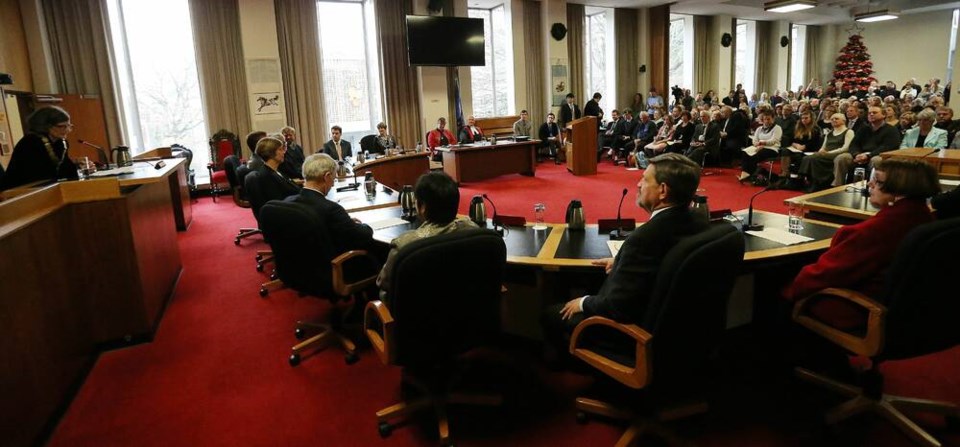Every day, or many times a day for those with enquiring minds, this newspaper, and the media generally, remind us of the need to merge and integrate our local governments. (‘Amalgamate’ was removed with intention.)
Les Leyne’s April 30 column, a review of the MLAs’ Report on south Island police, mentions the recommendation for “amalgamating police services, on a regional basis where there are opportunities to address fragmentation, ensure equitable access to policing and public safety, and improve efficiency and effectiveness, with some reference to local government.”
Esquimalt Mayor Barb Desjardins has suggested pulling out off the policing agreement with Victoria – but we should consider bringing together all our police and fire Departments.
I’ll suggest a name: Victoria Safety Authority. We know we live in Victoria, and a “Safety Authority” can accommodate services such as transit police and the 911 service. (Military operations would not be included except on an on-call basis during emergencies. )
We could, in conjunction with existing police and fire management, with provincial guidance, and with matching resource models for comparable service requirements, present a plan for this authority.
The authority could be funded for the first year through existing local authority budgets. It would need to be fully at arm’s length for management and budgeting from local politics, preferably a taxing authority responsible and responsive, billing the whole tax base.
With the biggest single grouping in a new order, our municipal non-safety services in management, labour relations and HR issues can take the first step toward merging and integrating. (The word ‘amalgamate’ does not give us the fine tuning and management of activities on a piece-by-piece basis that we can feel from merging and integrating.)
There will be several cycles of wage and benefit negotiations. Transparency will be needed in this process, and each reorganization should be based on the specific needs for that area. It will be important to find the most equitable merging and integrating of labour, which will require the best and most considerate HR (management side) and union (worker side) involvement.
As a very serious aside, please put away the idea of only Victoria and Saanich becoming a single entity. It was the previous two councils’ worst idea, to which we signed on to and permitted a gathering of $750,000.
However, with zero mandate outside their boundaries, regional municipal issues like police, fire, wages and salaries were excluded. We lose the big picture, and we still have no regional approach to much-needed housing, or to solve Esquimalt’s policing concerns.
Since the 1960s most of B.C. has used regional districts and municipal co-operation to merge and integrate services, and our future success for Victoria is really a minor, not massive, shift.
The full provincial model should have been implemented here in the 1960s, but we hunkered down and did the minimum. Today we have predictable inefficiencies and barely any of the clarity found in the rest of B.C.
Rural areas should not be in municipalities; they should be electoral areas in the Capital Regional District.
One more electoral area covering the rural areas of the Peninsula is likely needed. Saanich could be divided along the current urban containment boundary lines, which means the Blenkinsop Valley and Mount Douglas / P’Kols, for example, and the bulk of the closed Royal Oak Golf Course would be in the CRD as an electoral area.
Never lose autonomous urban areas such as Sidney and Sooke, but benefits of merging and integrating can come to them. We must call for and build capacity, with opportunities to listen and reconcile every Indigenous voice and governance need.
The CRD board controls water and sewer, and helps plan transportation and transit. Opportunities cry out for a singular regional housing body – the CRD already operates a department for supported housing – plus CRD-operated regional transportation and transit.
GIS maps will devolve to one consolidated map.
Some residents imagine a loss of staff, their current local workers, and helpful community minded staff will be moved. But surely, please leave alone municipal employees who give us 100 per cent service with everything: we cannot expect those same services if we stupidly move everyone around into new locations and positions for the sake of it. Let’s commit: this is not for reductions of line workers.
Capital and operating funding will be centralized: all Victoria’s urban and rural areas as one can make region-wide requests to senior government.
To work with the larger structure, Local Associations need strengthening and to be respected for all community planning. We may consider wards for the Victoria council, at least in the short term.
Our electorate voted over 85 per cent for change; so please call for merging and integrating. We can get there without a citizen’s assembly, which allows a random veto if a council doesn’t like it.
And while we are making major changes, let’s get back to three-year election cycles as we seek the best people for the new elected positions.
I speak above of yet one more set of options for the First Nations over these south Island lands with another remodel of governance affecting these unceded lands. There is a strong need to fully involve our First Nations friends and neighbours, and I apologize that this article was not preceded by or involved anyone from the local peoples in its development, some of whom I regard as friends and confidants. That would be the first step to take.
My scheme can indeed correct this, and lead to a greater and more comprehensive co-working with the First Nations friends, bringing them into an adjusted regional district structure for urban and rural discussion and solutions.
Our electorates have cried out to be heard on this matter. The furthest this got is the Richard Atwell/ Lisa Helps agreement to try an Citizen’s Assembly.
>>> To comment on this article, write a letter to the editor: [email protected]



